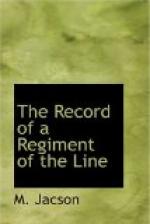The Liverpool Regiment lost at Helvetia 4 killed, 27 wounded, and 200 prisoners.
The Boers about this time attacked all along the line from Lydenburg to Pretoria. The defences, except at Lydenburg, were of the most meagre description. In fact, the works constructed by the Rifle Brigade and the Devons at Lydenburg were the only works of any strength, and these were as complete as possible. Witklip was being placed in a fortified condition, but up to the time of the taking of Helvetia Post little had been done anywhere, except at Lydenburg.
For the next few nights all posts round Lydenburg stood to arms at 1.30 a.m. owing to the activity of the Boers, but it was not till January 4th that they attacked the Bridge Hill Post. They attempted to capture the picquet on the bridge over the Spekboom River, but were beaten off.
About this time one company was ordered down from Paardeplaats to Mission Camp, the garrison at Paardeplaats being thus reduced to one company; and Witklip garrison was reinforced by the addition of one company, which was sent there from Mission Camp.
On the early morning of January 8th the Boers made a simultaneous attack on almost all posts on the line between Belfast and Lydenburg. The following posts were attacked: Badfontein, Schwarzkop, Helvetia, Machadodorp, Belfast, Pan, and Noitgedacht. The Badfontein Post was shelled only, by a big gun mounted on the hills west of the fort, which failed, however, to reach the post. The result of the general attack was that two posts only, those at Belfast, were captured by the Boers. These were not held, and the Boers retired, leaving twenty-four dead upon the ground. The posts had been well prepared for defence after the disaster at Helvetia.
A wire bridge over the Lydenburg River, constructed by Lieutenant Green and the twelve men of the Maxim gun team, was completed about this time, and as it attracted a good deal of attention a description of it may be interesting.
The bridge had a span of sixty feet, and was constructed on the system of the “jhula,” or rope bridge, of Cashmere, out of telegraph wire. The roadway, to admit of one person at a time, was made of two lengths of twisted wire, each ten strands thick. These being stretched tightly across the river, and the ends well worked into the ground and pegged down, were joined together by small laths of wood two inches apart. Two more lengths, each ten strands thick, were stretched from two uprights on each bank, at a convenient height above the roadway, to form a support for it. These were joined on to the roadway by stout sticks, about one to two feet apart, on either side to give stability. The bridge was then secured up and down stream by wires to keep it steady. The height of the bridge above the stream was about twenty feet.
[Illustration: Wire Bridge, Lydenburg]




